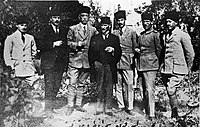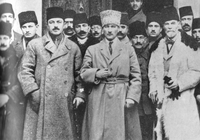Turkish National Movement
This articleneeds additional citations forverification.(July 2014) |
| Turkish National Movement | |
|---|---|
| Türk Ulusal Hareketi | |
 Prominent nationalists at theSivas Congress.Left to right:Ahmet Muzaffer(Kılıç),Rauf Bey(Orbay),Bekir Sami(Kunduh),Mustafa Kemal(Atatürk),Ruşen Eşref(Ünaydın),Cemil Cahit(Toydemir),Cevat Abbas(Gürer). | |
| Leader | Mustafa Kemal Pasha |
| Dates of operation | June 22, 1919–October 29, 1923 |
| Country | |
| Allegiance | |
| Motives | Opposition to thepartition of the Ottoman Empire |
| Headquarters | Ankara |
| Active regions | Anatolia,Thrace |
| Ideology | Turkish nationalism |
| Allies | |
| Opponents | |
| Battles and wars | Turkish War of Independence |
TheTurkish National Movement(Turkish:Millî Hareket), also known as theAnatolian Movement(Turkish:Anadolu Hareketi), theNationalist Movement(Turkish:Milliyetçi Hareket), and theKemalists(Turkish:Kemalîler,KemalcilerorKemalistler),[5][6]included political and military activities of the Turkish revolutionaries that resulted in the creation and shaping of the modernRepublic of Turkey,as a consequence of the defeat of theOttoman EmpireinWorld War Iand the subsequentoccupation of Constantinopleandpartitioning of the Ottoman Empireby theAlliesunder the terms of theArmistice of Mudros.The Turkish revolutionaries rebelled against this partitioning and against theTreaty of Sèvres,signed in 1920 by the Ottoman government. Most revolutionaries were former members of theCommittee of Union and Progress.
This establishment of an alliance of Turkish revolutionaries during the partitioning resulted in theTurkish War of Independence,thegenocidesof the Anatolian native nations, theabolition of the Ottoman sultanateon 1 November 1922 and the declaration of the Republic ofTurkeyon 29 October 1923. The movement organized itself into theAssociation for the Defence of National Rights of Anatolia and Rumeli,which eventually declared that the only source of governance for theTurkish peoplewould be theGrand National Assembly of Turkey.
The movement was created in 1919 through a series of agreements and conferences throughout Anatolia andThrace.The process was aimed to unite independent movements around the country to build a common voice and is attributed toMustafa Kemal Atatürk,[7]as he was the primary spokesperson, public figure, and military leader of the movement.
Amasya Agreement, June 1919
[edit]The Amasya Agreement was important in many respects. It was the first call to the national movement against the occupying powers. It consisted of talks about national independence. The message read as follows:
- The unity of the motherland and national independence are in danger.
- The Istanbul government is unable to carry out its responsibilities.
- It is only through the nation's effort and determination that national independence will be won.
- It is necessary to establish a national committee, free from all external influences and control, that will review the national situation and make known to the world the peoples desires for justice.
- It has been decided to hold immediately a National Congress inSivas,the most secure place in Anatolia.
- Three representatives from each province should be sent immediately to the Sivas Congress.
- To be prepared for every eventuality, this subject should be kept a national secret.
- There will be a congress for the Eastern Provinces on July 10. The delegation from the Erzurum Congress will depart to join to the general meeting in Sivas.
This agreement was signed byMustafa Kemal Atatürk,Rauf Orbay,Ali Fuat Cebesoy,Refet Beleand laterKâzım KarabekirinErzurum.
Conferences
[edit]Erzurum Congress, August 1919
[edit]
On American Mandate:On 1 August 1919, the King-Crane Commission tried to contact a large groups of interested parties in Constantinople (Ottoman Control), to obtain their positions with a view toward reporting them to the Paris Peace Conference.Kazım Karabekirlearned that a memorandum was adopted by an amalgamation of political groups in Constantinople and consequently, the Erzurum Congress, which has been in session since 23 July (until 7 August 1919) sent a memorandum toAmerican PresidentWoodrow Wilsonon the same day (1 August). It was probably also meant to remind all other parties ofWilson's 14 Pointsand the fact that the Nationalists were aware of them. Among the objectives of the Nationalists was, it appears, to signal the resolve of the Nationalists to the interested parties, and display their intent not to tolerate indiscriminate political pressure. What began as a suggestion to the Nationalists to accept the American Mandate at the time of the Erzurum Congress, became a major campaign immediately afterwards. By the time Sivas Congress was convened, no less than three channels were working on the Nationalist leadership to persuade them at least to "consider" the American Mandate, if not outright adopt a resolution in favor of it at the Sivas Congress.
Sivas Congress, September 1919
[edit]
The Sivas Congress was the first time the fourteen leaders of the movement united under a single roof. These people formed a plan between 16 and 29 October. They agreed that the parliament should meet in Constantinople, even if it were obvious that this parliament could not function under the occupation. It was a great chance to build the base and legitimacy. They decided on formalizing a "Representative Committee" that would handle the distribution and implementation, which could easily be turned into a new government if allies decided to disband the whole Ottoman Governing structure. Mustafa Kemal established two concepts into this program: independence and integrity. Mustafa Kemal was setting the stage for conditions which would legitimize this organization and illegitimate the Ottoman parliament. These conditions were also mentioned in the Wilsonian rules.
Mustafa Kemal opened the National Congress at Sivas, with delegates from the entire nation taking part. The Erzurum resolutions were transformed into a national appeal, and the name of the organization changed to the Society to Defend the Rights and Interests of the Provinces of Anatolia and Rumeli. The Erzurum resolutions were reaffirmed with minor additions, these included new clauses such as article 3 which states that the formation of an independent Greece on theAydın,Manisa,andBalıkesirfronts was unacceptable. The Sivas Congress essentially reinforced the stance taken at the Erzurum Congress. All these were performed while the Harbord Commission arrived inConstantinople.[8]
Amasya Protocol, October 1919
[edit]Grand National Assembly, April 1920
[edit]Plans were made to organize a new government and parliament in Ankara, and the sultan asked to accept its authority. A flood of supporters moved to Ankara just ahead of the Allied dragnets. Included among them wereHalide Edip,her husband,Adnan Adıvar,İsmet İnönü,Kemal’s most important allies in the Ministry of War, and the last president of the Chamber of Deputies,Celalettin Arif.The latter's desertion of the capital was of great significance. A legally elected president of the last representative Ottoman Parliament, he claimed that it had been dissolved illegally, in violation of the Constitution, enabling Kemal to assume full governmental powers for the Ankara regime.
On March 1920, he announced that the Turkish nation was establishing its own Parliament in Ankara under the nameGrand National Assembly.Some 100 members of the Ottoman Parliament were able to escape the Allied roundup and joined 190 deputies elected around the country by the national resistance group. On April 23, 1920, the new Assembly gathered for the first time, making Mustafa Kemal its first president and İsmet Inonü, now deputy fromEdirne,chief of the General Staff.
Organizations associated with the movement
[edit]Political parties
[edit]- Anatolia and Rumeli Defence of Law Association–Anadolu ve Rumeli Müdâfaa-i Hukuk Cemiyeti
- National Salvation Group –Felah-ı Vatan Cemiyeti
- Renewal Party–Teceddüt Fırkası
- Ottoman Liberal People's Party–Osmanlı Hürriyetperver Avam Fırkası
- Ottoman Labour Party –Osmanlı Mesai Fırkası
- National Turk Party –Millî Türk Fırkası
- Turkish Communist Party–Türkiye Komünist Fırkası
Associations for the Defence of National Law
[edit]- Eastern Anatolia Defence of Law Association –Şarkî Anadolu Müdafaa-i Hukuk Cemiyeti
- İzmirOttoman Defence of Law Association –İzmir Müdafaa-i Hukuku Osmaniye Cemiyeti
- Salvation of the Homeland Association –İstihlası Vatan Cemiyeti
- Thrace-Paşaeli Defence of Law Association –Trakya-Paşaeli Müdafaa-i Hukuk Cemiyeti
- TrabzonConservation of Law National Association –Trabzon Muhafaza-i Hukuku Milliye Cemiyeti
- CiliciansAssociation –Kilikyalılar Cemiyeti
- National Movement and Rejection of Annexation Organizations –Hareket-i Milliye ve Redd-i İlhak Teşkilatları
- AdanaVilayet Defence of Law Association –Adana Vilayeti Müdafaa-i Hukuk Cemiyeti
- KozanDefence of Law Association –Kozan Müdafaa-i Hukuk Cemiyeti
- Anatolia Woman's Defence of the Homeland Association –Anadolu Kadınları Müdafaa-i Vatan Cemiyeti
- BalıkesirRejection of Annexation Association –Balıkesir Redd-i İlhak Cemiyeti
- SamsunDefence of Law Association –Samsun Müdâfaa-i Hukuk Cemiyeti
NGOs
[edit]- Turkish Hearths–Türk Ocakları
- Auspicious Society –Cemiyyet-i Hayriye
Militaries and paramilitaries
[edit]- National Forces–Kuva-yi Milliye
- Ordered Forces–Kuva-yi Nizamiye
- Traveling Forces(Green Army Organization) –Kuva-yi Seyyare
Intelligence organizations
[edit]- Black Arm Association (Karakol Society) –Karakol Cemiyeti
- Mim Mim Group –Mim Mim Grubu
- Hamza Group –Hamza Grubu
- Officer's Group –Zabitân Grubu
- Yavuz Group –Yavuz Grubu
Provisional national governments
[edit]- Committee of Representation–Heyet-i Temsiliye
- Government of the Grand National Assembly(Ankara Government) –Büyük Millet Meclisi Hükûmeti
Provisional regional governments
[edit]- Aras Republic–Araz Respublikası
- Iğdır National Republic –Iğdır Millî Cumhuriyeti
- Provisional National Government of the Southwestern Caucasus–Cenub-ı Garbi Kafkas Hükûmet-i Muvakkate-i Milliyesi
- Oltu Council Government –Oltu Şura Hükûmeti
Conclusion
[edit]After the establishment of the movement and the successfulTurkish War of Independence,the revolutionaries abolished theOttomansultanate on November 1, 1922, and proclaimed the Republic ofTurkeyon October 29, 1923. The movement terminated theTreaty of Sèvresand negotiated theTreaty of Lausanne,assuring recognition of the national borders, termedMisak-ı Millî(National Pact).
The national forces were united around the leadership ofMustafa Kemal Atatürkand the authority of theGrand National Assemblyset up inAnkara,which pursued the Turkish War of Independence. The movement gathered around the idea ofthe integrationof the other native populations (Greeks,Armenians,Assyrians) to make Turkish nation-state and a progressively defined political ideology that is generally termed "Kemalism",or" Atatürkçülük "(" Atatürkism "). Its basic principles stress theRepublic- a form of government representing the power of the electorate, secular administration (laïcité),nationalism,a mixed economy with state participation in some sectors (as opposed tostate socialism), and national modernization.
Turkish revolutionaries were mainly influenced by ideas which flourished during theTanzimatperiod. The revolutionaries should not be associated with theYoung Turkmovement of the same era, which was tightly bound to the Ottoman State and the ideals ofOttomanism.Turkish revolutionaries indeed were not a homogeneous group of people, as they had different ideas on social and political issues. There were years in which most of them did not communicate with each other, even though they presided over the major social and political institutions. The common idea which held them together was having asovereignnation.
See also
[edit]- Turkish War of Independence
- List of high-ranking commanders of the Turkish War of Independence
- Kuva-yi Milliye
References
[edit]- ^The Place of the Turkish Independence War in the American Press (1918–1923)by Bülent Bilmez:"...the occupation of western Turkey by the Greek armies under the control of the Allied Powers, the discord among them was evident and publicly known. As the Italians were against this occupation from the beginning, and started" secretly "helping the Kemalists, this conflict among the Allied Powers, and the Italian support for the Kemalists were reported regularly by the American press.
- ^Sforza, Diario, November 28, 1920, 61/ David Lloyd George, The Truth about the Peace Treaties, v. 2 (Gollancz, London: 1938), pp. 1348–1349 / Michael Smith,Ionian Vision: Greece in Asia Minor, 1919–1922,University of Michigan Press, 1999.
- ^Ζολώτα, Αναστασίου Π. (1995).Η Εθνική Τραγωδία(National Tragedy). Αθήνα, Πανεπιστήμιο Αθηνών, Τμήμα Πολιτικών (University of Athens) Επιστημών και Δημοσίας Διοικήσεως. σελίδες pp. 44–58
- ^«ΤΑ ΦΟΒΕΡΑ ΝΤΟΚΟΥΜΕΝΤΑ – ΣΑΓΓΑΡΙΟΣ ΕΠΟΠΟΙΪΑ ΚΑΙ ΚΑΤΑΡΕΥΣΗ ΣΤΗΝ ΜΙΚΡΑ ΑΣΙΑ», ΔΗΜ. ΦΩΤΙΑΔΗΣ, ΕΚΔ. ΦΥΤΡΑΚΗ, ΑΘΗΝΑ, 1974
- ^"1919’dan bugüne kurtuluşun anahtarı Kemalizm"(in Turkish)
- ^"Kemalizm"(in Turkish)
- ^Atatürk and the Turkish NationSource US Library of Congress
- ^Finkel, Caroline, Osman's Dream, (Basic Books, 2005), 57; "Istanbul was only adopted as the city's official name in 1930..".
Further reading
[edit]- Zürcher, Erik Jan (2021). "Contextualizing the ideology of the Turkish national resistance movement".Middle Eastern Studies.57(2): 265–278.doi:10.1080/00263206.2020.1858061.S2CID231741824.
External links
[edit]- .Encyclopædia Britannica(12th ed.). 1922.

